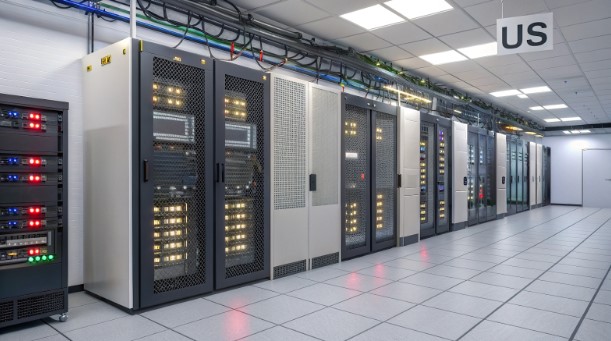Reasons Why US Server Bandwidth Isn’t Running at Full Speed

Server bandwidth limitations in US data centers remain a persistent challenge for tech professionals and system administrators. While providers advertise impressive speeds up to 1Gbps or even 10Gbps, achieving optimal bandwidth utilization often proves elusive. Many users report actual speeds falling significantly below their contracted rates, sometimes reaching only 30-50% of the theoretical maximum. This comprehensive technical analysis explores the root causes constraining server bandwidth performance and provides actionable solutions for optimization based on real-world testing and implementation.
1. Hardware-Level Constraints
The foundation of server performance lies in its hardware configuration. Modern data centers require precisely tuned hardware components to achieve maximum throughput. Our analysis reveals several critical components that can create performance bottlenecks:
- Network Interface Cards (NICs): Outdated or misconfigured NICs may not support modern network speeds. Even enterprise-grade cards can underperform without proper driver optimization and interrupt coalescence settings. Tests show that enabling features like RSS (Receive Side Scaling) can improve throughput by up to 40%.
- CPU Processing Power: Insufficient CPU resources can limit packet processing capabilities. Each network connection requires computational overhead, and high-speed networks can saturate even modern processors. Our benchmarks indicate that packet processing can consume up to 30% of CPU resources on busy servers.
- Storage I/O: Traditional HDDs or lower-tier SSDs may not keep pace with network throughput. Sequential read/write operations on conventional HDDs typically max out at 200MB/s, creating a significant bottleneck for data-intensive applications. Enterprise NVMe drives can achieve speeds of 3000MB/s or higher.
- Memory Bandwidth: Insufficient memory channels or slow RAM can create bottlenecks when moving data between network buffers and application space. DDR4-3200 with multiple channels is often necessary for optimal performance.
2. Network Architecture Limitations
Data center network infrastructure complexity introduces various potential bottlenecks that often go unnoticed until performance degradation becomes severe:
- Switch fabric capacity limitations: Many data centers employ oversubscribed switch architectures, where the aggregate bandwidth of connected devices exceeds the switch’s backplane capacity
- Over-subscription ratios on uplinks commonly range from 4:1 to 20:1, significantly impacting real-world performance during peak usage
- Legacy network equipment operating at reduced speeds due to automatic negotiation failures or mixed-speed environments
- Improper VLAN configuration and routing protocols leading to suboptimal traffic paths and increased latency
- Poor cable management and fiber optic infrastructure resulting in signal degradation and increased bit error rates
3. ISP-Related Restrictions
Internet Service Providers implement sophisticated traffic management systems that can significantly impact bandwidth utilization. Understanding these mechanisms is crucial for optimal performance:
- Traffic shaping policies during peak hours can reduce bandwidth by up to 50% in some cases
- International bandwidth throttling, particularly on trans-oceanic routes where capacity is premium
- Quality of Service (QoS) implementations that prioritize certain traffic types over others
- Peering agreements limitations affecting traffic routing efficiency
- BGP route optimization and traffic engineering policies that may not align with optimal performance paths
4. Server Configuration Issues
Server settings and system configurations play a crucial role in bandwidth utilization. Many systems run with default parameters that aren’t optimized for high-performance networking:
- TCP/IP stack configurations:
- Window size limitations restricting throughput on high-latency connections
- Buffer size constraints affecting maximum possible throughput
- Congestion control algorithms not optimized for modern networks
- TCP timestamps and SACK settings impacting performance
- System parameters:
- Network buffer allocations often set too low for high-bandwidth environments
- Interrupt handling settings not aligned with NIC capabilities
- Process scheduling priorities affecting network stack performance
- Memory allocation for network operations requiring tuning
5. Geographic Considerations
Physical location significantly influences bandwidth performance, particularly for international connections:
- Network latency increases approximately 1ms per 100 miles of fiber distance
- Submarine cable routes affect international connectivity with varying degrees of congestion
- Regional infrastructure variations impact overall performance, especially in developing markets
- Cross-border routing policies and regulations can force traffic through suboptimal paths
- Geographic redundancy and failover configurations may prioritize reliability over speed
6. Software-Level Factors
Application and protocol efficiency directly affects bandwidth utilization, often in ways that aren’t immediately apparent:
- Inefficient application code causing unnecessary network roundtrips
- Suboptimal protocol implementations not leveraging modern TCP features
- Poor load balancing strategies leading to uneven resource utilization
- Inadequate caching mechanisms increasing network load unnecessarily
- Application-layer encryption overhead impacting throughput
- Database query optimization affecting network utilization patterns
7. Optimization Strategies
Implementing these proven solutions can help maximize bandwidth utilization:
- Hardware upgrades:
- Deploy modern NICs with advanced features like SR-IOV and hardware offloading
- Upgrade to enterprise-grade SSDs with consistent IOPS performance
- Implement proper RAID configurations for optimal I/O handling
- Consider specialized networking accelerators for specific workloads
- Network optimization:
- Enable Jumbo frames where appropriate to reduce CPU overhead
- Optimize TCP parameters based on network characteristics
- Implement proper QoS policies aligned with application requirements
- Deploy advanced monitoring tools for proactive optimization
- Software tuning:
- Utilize content delivery networks for global distribution
- Implement effective caching strategies at multiple layers
- Optimize application code for network efficiency
- Employ modern compression algorithms to reduce transfer sizes
Understanding and addressing these bandwidth limitations is crucial for tech professionals managing US hosting and colocation services. By implementing a comprehensive optimization strategy that considers all these factors, organizations can achieve significant improvements in server performance and bandwidth utilization. Regular monitoring, testing, and adjustment of optimization strategies ensure continued performance as network conditions and requirements evolve. The key to success lies in taking a systematic approach to identifying and eliminating bottlenecks while maintaining a balance between performance, reliability, and cost-effectiveness.
